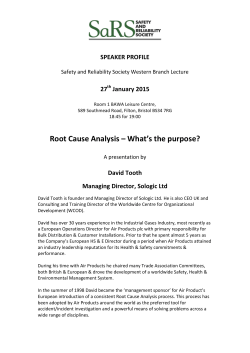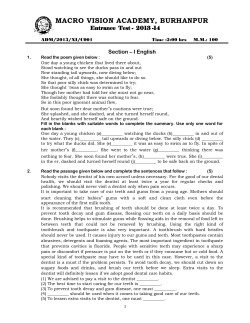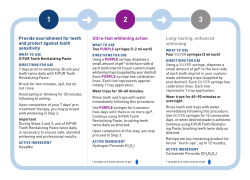
Application of Metallic Profiling of Teeth for Environmental and
Application of metallic profiling of teeth for Environmental and Forensic Science S. Hendry1, C. Morrison1, A. Hursthouse1, K. Spohr2 1 School of Science,2School of Engineering University of the West of Scotland, Paisley, UK Email contact: Stephen.Hendry@outlook.com Introduction Male teeth The human body can be exposed to various environments and surroundings that promote transfer of metals to the body in the air from pollution, soil and water from contamination and also in our diet from food sources containing metals. Male Arthritis teeth 1000000 1000000 100000 100000 10000 Metals found in the body will have dietary and/or environmental causes while analysis may help to indicate exposure to particular metals or geographical information assisting in both environmental science and forensic investigations. 1 2 1000 3 4 1 ug per gram ug per gram 10000 1000 2 3 4 100 5 100 5 10 10 1 Al Why Teeth Ca Fe K Mg Mn Na Pb Sr Al B Ba Ca Fe K Mg Mn Na Pb Sr 0.1 The healthy males teeth follows similar trends between elements however varies more significantly between samples in the arthritic teeth, specifically between calcium, iron, manganese and lead. This suggests that the male produce a more significant fingerprint of their historical content. • They are the hardest structures of the human body, relatively stable, not subject to turnover • Suitable for metal analysis over longer time scales and when investigating time specific concentrations of metals Females Arthritis teeth Female teeth Pre requisite to Human Teeth 1000000 1000000 100000 100000 10000 10000 1000 1000 1 ug per gram ug per gram • Relatively easy to collect following routine extraction or shedding. 100 4 100 5 10 1 1 Al B Ba Ca Fe 1 Tooth samples from Sprague Dawley rats were donated from another research project within UWS in accordance with the home office regulations. 2 3 10 Given the complexity of the matrix and potential problems associated with digestion and analysis methodology, a pilot study has been initiated using non human sources of sample to optimise the approach. 2 K 3 4 Mg Mn Pb Sr Al Zn 5 Ba Ca Fe K Mg Na Pb Sr 0.1 Preliminary conclusions Destructive and non-destructive tests were performed on the teeth via inductively coupled plasma atomic emission spectroscopy (ICP-AES) and scanning electron microscopy (SEM). Preliminary assessment suggests variability between : • Male / Female • Healthy / Unhealthy • Health / Treated • Location of tooth SEM was used to assess the feasibility for surface analysis by defining the transition effects between the root to the crown, gender and disease With enough replication to be consistent however will warrant further investigation of normalisation methods to remove natural variability Treated rats ICP-AES was used to infer the cumulative trace metal levels. 100000 10000 ug per gram The tooth samples were weighed out to approximately 0.02 ± 0.0035g and transferred to a 50ml digestion vessel. 1. 5ml of concentrated Nitric acid was added to the samples and left at room temperature overnight. Series1 1000 Series2 Series3 100 2. Samples were then refluxed at 110°C for 15minutes and then digested at the same temperature for 60minutes. 1 Al B Ba Bi Ca Fe K Mg Results Teeth from 50 males and 50 females were collected (50 left and 50 right for both genders) establishing 4 reference standards Male Left, Male Right, Female left and Female right. The relative standard deviations of the replicates are shown in the figure below % Relative Standard Deviations of self certified reference material Figure 1: Arthritic rats right tooth and elemental distribution 100 Na Pb Se Sr Zn Element Weight% Atomic% Element Weight% Atomic% OK 10.59 18.18 OK 7.00 12.26 Na K 31.02 37.07 Na K 33.87 41.26 Mg K 0.34 0.39 Mg K 0.05 0.06 Al K 0.33 0.34 Al K 0.14 0.14 Si K 0.25 0.25 PK 7.01 6.22 PK 3.49 3.16 Cl K 34.06 26.40 Cl K 47.19 37.28 Ca K 16.65 11.41 Ca K 8.01 5.60 Totals 100.00 Totals 100.00 Figure 2: Rats left tooth and elemental distribution Element Weight% Atomic% OK 3.51 6.25 Na K 38.27 47.35 0.18 PK 2.53 2.32 1.62 1.48 Cl K 49.09 39.39 Cl K 52.68 41.88 Ca K 6.61 4.69 Ca K 4.12 2.90 Totals 100.00 Totals 100.00 Element Weight% Atomic% OK 5.26 9.26 Na K 35.83 43.93 Mg K 0.32 0.37 Al K 0.17 PK Figure 3: Arthritic rats left tooth and elemental distribution Ongoing Work 90 80 70 • Complete analysis on the (ICP-MS) for the bulk of the remaining samples, still waiting to be analysed. 80.00 60 50 60.00 Mn Figure 4: Rats right tooth and elemental distribution All samples were ran alongside blank digestion standards, spiked samples both pre and post digestion and certified reference materials. The percentage recovery of the certified reference material is shown in the figure below. 100.00 The ICP results can be backed up with SEM results. SEM can offer a quick evaluation of the variability present for the surface of the tooth. However the SEM is hindered by its sensitivity resulting in the appearance of less variability when compared to the whole tooth. 10 3. Samples were allowed to cool to room temperature and then made up to 50ml (Rats Food) / 25ml (Rats Teeth) with UHP water. A further 1:10 dilution is carried out for ICP-MS analysis. 120.00 After looking at rats that have been treated for arthritis, irrespective of gender it suggests that the disease itself is the cause of the elemental concentrations and as a result has a more balanced distribution of composition. 1000000 Methodology 140.00 40 • Identify external influences such as age, gender, diet, weight, disease and sampling 40.00 30 20.00 20 10 0.00 Al Ba Ca Co Cr Cu Fe K Mg Element Limestone Bush and Branches Mn Pb Sr Zn 0 0 Soil 5 10 Female Left 15 20 Female Right 25 Male Left 30 Male Right Zn Comparison between healthy female rats and arthritic teeth it can be seen that there is less variation between samples with the arthritic teeth with regards to calcium but varies less with lead. The study acts as a prerequisite enabling the methodology to be validated on a similar structure and composition matrix. In this study, we used lower left and right mandibular incisors, which continually erupt and contain all stages of tooth formation. Certified reference material recovery Zn 1 Teeth are an ideal site to study exposure to trace metals since % Recovery Ba 35 40 • Statistically characterise the effects of metal composition between rats teeth and rats diet
© Copyright 2025















